|
|
|
The ancient Roman religion known as the Mithraic mysteries has captivated the imaginations of scholars for generations. There are two reasons for this fascination.
Owing to the cult's secrecy, we possess almost no literary evidence
about the beliefs of Mithraism. The few texts that do refer to the cult
come not from Mithraic devotees themselves, but rather from outsiders such
as early Church fathers, who mentioned Mithraism in order to attack it,
and Platonic philosophers, who attempted to find support in Mithraic
symbolism for their own philosophical ideas. However, although our
literary sources for the Mithraic mysteries are extremely sparse, an
abundance of material evidence for the cult exists in the many Mithraic
temples and artifacts that archaeologists have found scattered throughout
the Roman empire, from England in the north and west to Palestine in the
south and east. The temples, called mithraea by scholars, were usually
built underground in imitation of caves. These subterranean temples were
filled with an extremely elaborate iconography:
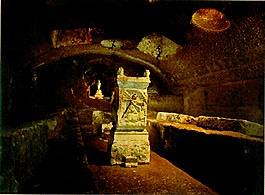 carved
reliefs, statues, and paintings, depicting a variety of enigmatic figures
and scenes. This iconography is our primary source
of knowledge about Mithraic beliefs, but because we do not have any
written accounts of its meaning the ideas that it expresses have proven
extraordinarily difficult to decipher.
carved
reliefs, statues, and paintings, depicting a variety of enigmatic figures
and scenes. This iconography is our primary source
of knowledge about Mithraic beliefs, but because we do not have any
written accounts of its meaning the ideas that it expresses have proven
extraordinarily difficult to decipher.
The typical mithraeum was a small rectangular subterranean chamber, on the order of 75 feet by 30 feet with a vaulted ceiling. An aisle usually ran lengthwise down the center of the temple, with a stone bench on either side two or three feet high on which the cult's members would recline during their meetings. On average a mithraeum could hold perhaps twenty to thirty people at a time. At the back of the mithraeum at the end of the aisle was always found a representation-- usually a carved relief but sometimes a statue or painting-- of the central icon of Mithraism: the so-called tauroctony or "bull-slaying scene" in which the god of the cult, Mithras, accompanied by a dog, a snake, a raven, and a scorpion, is shown in the act of killing a bull. Other parts of the temple were decorated with various scenes and figures. There were many hundreds-- perhaps thousands-- of Mithraic temples in the Roman empire. The greatest concentrations have been found in the city of Rome itself, and in those places in the empire (often in the most distant frontiers) where Roman soldiers-- who made up a major segment of the cult's membership-- were stationed. Our earliest evidence for the Mithraic mysteries places their appearance in the middle of the first century B.C.: the historian Plutarch says that in 67 B.C. a large band of pirates based in Cilicia (a province on the southeastern coast of Asia Minor) were practicing "secret rites" of Mithras. The earliest physical remains of the cult date from around the end of the first century A.D., and Mithraism reached its height of popularity in the third century. In addition to soldiers, the cult's membership included significant numbers of bureaucrats and merchants. Women were excluded. Mithraism declined with the rise to power of Christianity, until the beginning of the fifth century, when Christianity became strong enough to exterminate by force rival religions such as Mithraism.
For most of the twentieth century it has been assumed that Mithraism was imported from Iran, and that Mithraic iconography must therefore represent ideas drawn from ancient Iranian mythology. The reason for this is that the name of the god worshipped in the cult, Mithras, is a Greek and Latin form of the name of an ancient Iranian god, Mithra; in addition, Roman authors themselves expressed a belief that the cult was Iranian in origin. At the end of the nineteenth century Franz Cumont, the great Belgian historian of ancient religion, published a magisterial two-volume work on the Mithraic mysteries based on the assumption of the Iranian origins of the cult. Cumont's work immediately became accepted as the definitive study of the cult, and remained virtually unchallenged for over seventy years.
There were, however, a number of serious problems with Cumont's assumption that the Mithraic mysteries derived from ancient Iranian religion. Most significant among these is that there is no parallel in ancient Iran to the iconography which is the primary fact of the Roman Mithraic cult. For example, as already mentioned, by far the most important icon in the Roman cult was the tauroctony. This scene shows Mithras in the act of killing a bull, accompanied by a dog, a snake, a raven, and a scorpion; the scene is depicted as taking place inside a cave like the mithraeum itself. This icon was located in the most important place in every mithraeum, and therefore must have been an expression of the central myth of the Roman cult. Thus, if the god Mithras of the Roman religion was actually the Iranian god Mithra, we should expect to find in Iranian mythology a story in which Mithra kills a bull. However, the fact is that no such Iranian myth exists: in no known Iranian text does Mithra have anything to do with killing a bull.
Franz Cumont had responded to this problem by focusing on an ancient Iranian text in which a bull is indeed killed, but in which the bull-slayer is not Mithra but rather Ahriman, the force of cosmic evil in Iranian religion. Cumont argued that there must have existed a variant of this myth-- a variant for which there was, however, no actual evidence-- in which the bull-slayer had been transformed from Ahriman to Mithra. It was this purely hypothetical variant on the myth of Ahriman's killing of a bull that according to Cumont lay behind the tauroctony icon of the Roman cult of Mithras.
In the absence of any convincing alternative, Cumont's explanation satisfied scholars for more than seventy years. However, in 1971 the First International Congress of Mithraic Studies was held in Manchester England, and in the course of this Congress Cumont's theories came under concerted attack. Was it not possible, scholars at the Congress asked, that the Roman cult of Mithras was actually a new religion, and had simply borrowed the name of an Iranian god in order to give itself an exotic oriental flavor? If such a scenario seemed plausible, these scholars argued, one could no longer assume without question that the proper way to interpret Mithraism was to find parallels to its elements in ancient Iranian religion. In particular, Franz Cumont's interpretation of the tauroctony as representing an Iranian myth was now no longer unquestionable. Thus from 1971 on, the meaning of the Mithraic tauroctony suddenly became a mystery: if this bull-slaying icon did not represent an ancient Iranian myth, what did it represent?
Within a few years after the 1971 Congress, a radically different approach to explaining the tauroctony began to be pursued by a number of scholars. It is not an exaggeration to say that this approach has in just the past few years succeeded in completely revolutionizing the study of the Mithraic mysteries. According to the proponents of this interpretation, the tauroctony is not, as Cumont and his followers claimed, a pictorial representation of an Iranian myth, but is rather something utterly different: namely, an astronomical star map!
This remarkable explanation of the tauroctony is based on two facts:
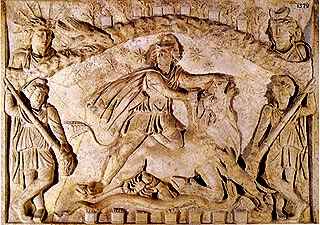 planets, sun, moon, and stars are often portrayed in Mithraic art (note
for example the stars around the head of Mithras in the carving of the
tauroctony); in addition, numerous ancient authors speak about
astronomical subjects in connection with Mithraism.
planets, sun, moon, and stars are often portrayed in Mithraic art (note
for example the stars around the head of Mithras in the carving of the
tauroctony); in addition, numerous ancient authors speak about
astronomical subjects in connection with Mithraism. In the writings of the Neoplatonic philosopher Porphyry, for example, we find recorded a tradition that the cave which is depicted in the tauroctony and which the underground Mithraic temples were designed to imitate was intended to be "an image of the cosmos." Given the general presence of astronomical motifs in Mithraic art and ideology, the parallel noted above between the tauroctony-figures and constellations is unlikely to be coincidence. Let me recommend a good book on this issue: The Origins of The Mithraic Mysteries by David Ulansey.
In order to understand the connection of Mithra with Christianity we must first have in mind a few facts about ancient cosmology. Today we know that the earth rotates on its axis once a day, and revolves around the sun once a year. However, Greco-Roman astronomy at the time of the Mithraic mysteries was based on a so-called "geocentric" cosmology, according to which the earth was fixed and immovable at the center of the universe and everything went around it. In this cosmology the universe itself was imagined as being bounded by a great sphere to which the stars, arranged in the various constellations, were attached. So, while we today understand that the earth rotates on its axis once every day, in antiquity it was believed instead that once a day the great sphere of the stars rotated around the earth, spinning on an axis that ran from the sphere's north pole to its south pole. As it spun, the cosmic sphere was believed to carry the sun along with it, resulting in the apparent moment of the sun around the earth once a day.
As necessary background we need to understand that there are 12 signs of the Zodiac and 36 associated constellations or decans. The sun, from our perspective on earth, pass through these 12 constellations as we view the sun as the earth rotates around it. It appears as if the sun is moving through these constellations when in reality we view the sun from different perspectives as it is seen against the backdrop of these constellations. Now these 12 signs or constellations are also known as the signs of the Zodiac. The word Zodiac comes from the old word "zoad" meaning the way or a step which gave rise to the word "zodiacus" which means a circuit which describes exactly what the sun is doing as it passes through these signs. The sun passes through one of these steps each month. The full 12 steps make up the course of one year. Thus we see that each constellation or sign must be about 30 degrees long. The season of the year can be noted by the constellation that the sun is passing through at any given moment or time.
The influence of the Zodiac is extensive. The Jewish historian Josephus, followed by Clement of Alexandria in A.D. 200 surmised that the 12 stones in the breastplate of Aaron which spoke of the twelve tribes of Israel also referred to the 12 zodiacal signs. Again we must take notice of the influence of Alexandria and astrology on the theology of the early Church Fathers.
Astrology had its beginning at the Tower of Babel with a man names Nimrod who the Scriptures describe as being a mighty rebel against God. Nimrod built a mighty tower with the heavenlies in its top used for the purpose of horoscope casting and instituted a powerful priesthood to bring the people under the direct influence of the powers of darkness. At the same time he tried to set up a one world government but God stepped in and confused the languages. Astrology has always been connected with witchcraft and the occult since its very beginning and as such is forbidden by God. Astrology assets that your character and future were fixed by the position of the sun, moon, and the planets at your birth. Modern astrology is further discredited by the fact that the horoscope charts used today were drawn up nearly two thousand years ago. This means that due to the law of precession of the equinoxes (which has to do with the "wobble" of the earth's axis-causing the westward movement at about 1 degree every 70 years) those charts are today inaccurate by about 28 days. The sun appearing to have moved back through the circuit of its movement through the zodiacal constellations. This means that if you believed your sign to be Scorpio, for example, it is really Libra. The sun being in the constellation of Libra is in reality in Scorpio. This totally discredits this false religion. What again is important for our understanding is that astrology became the basis of many world religions and this "astro-theology" became the very core of Christianity as well as the earliest believers had adopted and borrowed from their pagan neighbors astrological concepts which they personified in solar-myths about their respective heroes; Jesus was not an exception!
The celestial equator consists of the projection of the earth's equator onto the celestial sphere. This produces an imaginary circle in the sky which is inclined at an angle of twenty-three degrees to the other major celestial circle, namely, the ecliptic or zodiac, which is the circle in which the sun, moon, and planets appear to move against the background of the fixed stars. The celestial equator and the ecliptic intersect at two points, [forming a cross], and these two crosses or points are the equinoxes: the places where the sun, in its movement through the zodiac as seen from the earth, and is understood as the first days of spring and autumn. But understand this was understood to happen not on earth; the sun was submitted to these "crosses" in the heavens. The sun was crucified in the heavens. The ancients understood that the seasons were changed and determined by the travel of the sun; either above or below the equator. When the sun, which was though to be dead in winter with the longer days of darkness, rose above the equator, then the sun was subjected to this "cross" in its movement above the celestial equator in its elliptical orbit; the sun was though to be subjected to this "cross" or "crucified" and after 3 days, when the sun remained at the lowest point in the horizon and thought to be dead, it miraculously began it upward trajectory and with it the promise of spring and new life was now on its way. The ancients understood this as the "sun being crucified on the cross."
The celestial equator is not as obscure a concept as might first
appear, and certainly was not obscure in antiquity. For in the ancient
geocentric (earth-centered) vision of the cosmos, the universe was built
upon a 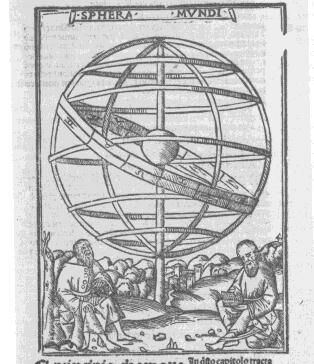 framework
whose basic structure was provided by the two celestial circles of the
ecliptic and the celestial equator. The picture shows a Renaissance
diagram of the cosmic framework, the "skeleton of the universe,"
in which the celestial equator is the horizontal circle around the
middle of the cosmic sphere, while the ecliptic or zodiac is the
tilted circle. The other circles in the diagram, such as the tropics
(the horizontal circles immediately above and below the celestial
equator), provided a more detailed division of the cosmic sphere, but were
always of secondary importance to the primary division of the sky
according to the two circles of the ecliptic and the celestial equator.
Thus, we often find in antiquity images of the cosmic sphere on which are
placed just these two circles.
framework
whose basic structure was provided by the two celestial circles of the
ecliptic and the celestial equator. The picture shows a Renaissance
diagram of the cosmic framework, the "skeleton of the universe,"
in which the celestial equator is the horizontal circle around the
middle of the cosmic sphere, while the ecliptic or zodiac is the
tilted circle. The other circles in the diagram, such as the tropics
(the horizontal circles immediately above and below the celestial
equator), provided a more detailed division of the cosmic sphere, but were
always of secondary importance to the primary division of the sky
according to the two circles of the ecliptic and the celestial equator.
Thus, we often find in antiquity images of the cosmic sphere on which are
placed just these two circles.
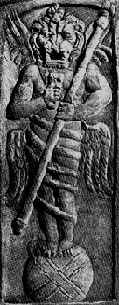 In
fact, one of the earliest surviving examples of such representations is a
Mithraic monument portraying the lion-headed
god standing on a cosmic sphere on which are shown the two intersecting
circles of the ecliptic and the celestial equator. Looking at
the Renaissance picture and the Lion-headed god on the globe we can also
see why these two circles were often seen as
constituting a cross, with their
intersection representing the equinoctial point
where the circles meet. One of the most famous and important
references to this cross formed by the ecliptic and the celestial equator
is found in Plato's dialogue Timaeus, where Plato tells us how the
Demiurge (the creator of the universe) constructed the universe out of two
circles which he joined "in the form of the letter
X (the X as understood as the symbol for the
cross in the heavens). The sun was later personified in the various
nations and became the heroes of mythology who were "crucified before
the foundation of the world" (sound familiar)?
In
fact, one of the earliest surviving examples of such representations is a
Mithraic monument portraying the lion-headed
god standing on a cosmic sphere on which are shown the two intersecting
circles of the ecliptic and the celestial equator. Looking at
the Renaissance picture and the Lion-headed god on the globe we can also
see why these two circles were often seen as
constituting a cross, with their
intersection representing the equinoctial point
where the circles meet. One of the most famous and important
references to this cross formed by the ecliptic and the celestial equator
is found in Plato's dialogue Timaeus, where Plato tells us how the
Demiurge (the creator of the universe) constructed the universe out of two
circles which he joined "in the form of the letter
X (the X as understood as the symbol for the
cross in the heavens). The sun was later personified in the various
nations and became the heroes of mythology who were "crucified before
the foundation of the world" (sound familiar)?
Before we can go on, we need to add one more crucial fact to the description of the celestial equator, namely, that the celestial equator is not completely stationary but actually possesses a very slow movement known as the precession of the equinoxes. This movement is caused by a wobble in the earth's rotation on its axis, which results in a slow, progressive change in the orientation of the earth in space. Thus, for example, the earth's North Pole does not always point to the same star. Although now it points in the direction of the star known as Polaris, a few thousand years ago a different star marked the pole, and a few thousand years in the future the pole will point to yet another star. Of course, if the orientation of the pole is changing, so is the orientation of the earth's equator, which is defined as a circle on the earth equidistant from the poles. The result of this change in orientation of the earth's equator is, naturally, a corresponding shift in the position of the celestial equator. This change in position of the celestial equator is most often described in terms of its effect on the position of the equinoxes (the points where the equator crosses the zodiac). Thus the phenomenon is known as the precession of the equinoxes. As a result of this wobble, the celestial equator appears to change its position over the course of thousands of years.
Put most simply, then, the precession of the equinoxes results in a slow movement of the equinoctial points backward through the zodiac, moving through one constellation every 2,160 years and thus through the entire zodiac in 12 times 2,160, or 25,920 years. Thus, at the present time the spring equinox occurs when the sun is in the constellation of Pisces but in a few hundred years the equinox will be in the constellation of Aquarius (the so-called dawning of the Age of Aquarius). And, more to our point here, in Graeco-Roman times the spring equinox was in the constellation of Aries, and the autumn equinox was in Libra. When one looks to Egypt and the times before the Graeco-Roman times we find the spring equinox was in the constellation of Taurus and the autumn equinox was in Scorpius for example. This explains why there was so much "bull" symbolism in Egypt. But that was to change with the Hyskos Shepherd Kings as these Pharaohs saw the change in the heaven and wars were fought over changing the religious emphasis of Egyptian worship from "Taurus" oriented to "Aries" or "lamb" oriented approaches to religious worship. We must not forget that these "changes" took 2,160 years.
The tauroctony symbolism clearly includes Taurus and Scorpius instead of Aries and Libra, which, as the equinoctial constellations in Graeco-Roman times, should have been pictured in any representation of the contemporary celestial equator.
However, the phenomenon of the precession of the equinoxes can also provide us with a possible solution to the problem of the unexpected presence of Taurus and Scorpius in the tauroctony in place of Aries and Libra. For although the equinoxes were in Aries and Libra in Graeco-Roman times, the equinoxes last positions before that were in Taurus and Scorpius, a situation which lasted from about 4000 B.C.E. to 2000 B.C.E. The tauroctony does indeed represent the celestial equator, but that it represents the celestial equator as it was when the equinoxes were in Taurus and Scorpius rather than in Aries and Libra (represented the equinoxes during the age two thousand years ago).
Starting with Taurus and moving west, the equator passes through the following—and only the followings— constellations on or below the ecliptic:
As will be seen immediately, these are precisely the constellations which are paralleled in the tauroctony, except that Leo the lion is missing. However, Leo also fits perfectly into our hypothesis that the tauroctony represents the astronomical situation which existed when the spring equinox was in Taurus. For although the celestial equator did not pass through Leo when the spring equinox was in Taurus, Leo was at that time the location of the summer solstice, which along with the equinoxes is shifted by the earth's precession. The solstices are, of course, inextricably linked with the equinoxes, since the solstices and equinoxes taken together divide the year into the four seasons. It is therefore easy to see how the constellation of Leo—the position of the summer solstice when the spring equinox was in Taurus—could have come to be incorporated into the tauroctony. To summarize, the tauroctony represents the astronomical situation which was obtained during the epoch in which the spring equinox was in Taurus, the fact that the summer solstice was in Leo during that epoch provides a convincing explanation for the occasional presence of the figure of a lion in the tauroctony.
With this as a background Mithras was viewed as a god whose
essential quality was in his power over the entire cosmos as was know as a
kosmokrator
(cosmic ruler). Mithras is shown a number of times holding in
his hand a globe representing the cosmic sphere having two intersecting
circles of the zodiac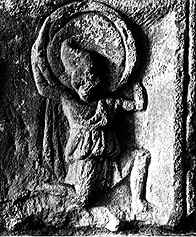 and the celestial equator marked on it. Mithras in the role of Atlas,
supports on his shoulder, as Atlas traditionally does, the great sphere of
the universe. We also see
and the celestial equator marked on it. Mithras in the role of Atlas,
supports on his shoulder, as Atlas traditionally does, the great sphere of
the universe. We also see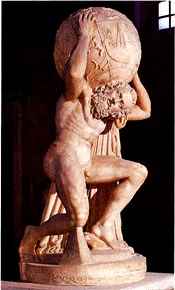 Mithras holding the cosmic globe, his role of kosmokrator is certainly
intended to be suggested by a number of tauroctonies which show the
bull-slaying scene taking place within an arch or circle formed by the
zodiac. Putting this all together, the cosmic
power of Mithras was manifested in his ability to end the Age of Taurus
and begin a new age by shifting the fundamental structure of the universe.
The god Mithras demonstrated his ability to end one world age and begin
another by killing the bull (ending the age of Taurus); thus indicating
Mithras control over the fundamental structure of the universe.
Mithras is responsible for the procession of the equinoxes and has the
ability to control the position of the cosmic pole.
Mithras holding the cosmic globe, his role of kosmokrator is certainly
intended to be suggested by a number of tauroctonies which show the
bull-slaying scene taking place within an arch or circle formed by the
zodiac. Putting this all together, the cosmic
power of Mithras was manifested in his ability to end the Age of Taurus
and begin a new age by shifting the fundamental structure of the universe.
The god Mithras demonstrated his ability to end one world age and begin
another by killing the bull (ending the age of Taurus); thus indicating
Mithras control over the fundamental structure of the universe.
Mithras is responsible for the procession of the equinoxes and has the
ability to control the position of the cosmic pole.
Mithraic iconography often portrays Mithras involved in various activities in conjugation with the sun god Helios or Sol. Many of the scenes represent Mithras as a power superior to Helios or Sol and we find these sun-gods kneeling before Mithras in a gesture of submission. Since Mithras controls the entire cosmic structure he therefore possesses a power greater than that of any other divinity, certainly greater than that of the sun who is part of the cosmic structure that Mithras controls. The sun has no choice but to kneel before Mithras in recognition of his superiority. We even find numerous inscriptions in which Mithras is himself called "the unconquered sun" (sol invictus). At times such iconography depicts Mithras and Sol as equals which means that Mithras and Sol have in common their shared role of kosmokrator, making them friendly allies and companions in various heroic deeds.
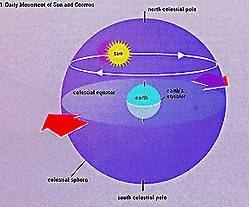 This
diagram shows the daily rotation of the cosmic sphere around the earth
according to the "geocentric" cosmology. As shown here, the sun
is carried along by the cosmic sphere around the earth once a day.
However, as explained above, in the "geocentric" cosmology the
sun was also believed to possess a second movement beyond its daily
rotation with the cosmic sphere: namely, its yearly revolution along the
circle of the "zodiac."
This
diagram shows the daily rotation of the cosmic sphere around the earth
according to the "geocentric" cosmology. As shown here, the sun
is carried along by the cosmic sphere around the earth once a day.
However, as explained above, in the "geocentric" cosmology the
sun was also believed to possess a second movement beyond its daily
rotation with the cosmic sphere: namely, its yearly revolution along the
circle of the "zodiac."
In addition to this daily rotation of the cosmic sphere carrying the
sun along with it, the ancients also attributed a second, slower motion to
the sun. While today we know that the earth revolves around the sun once a
year, in antiquity it was believed instead that once a year the sun--
which was understood as being closer to the earth than the sphere of the
stars-- traveled around the earth, tracing a great circle in the sky
against the background of the constellations. This circle traced by the
sun during the course of the year was known as the "zodiac"-- a
word meaning "living figures," which was a reference to the
fact that as the sun moved along the circle of the zodiac it passed in
front of twelve different constellations which were represented as having
various animal and human forms.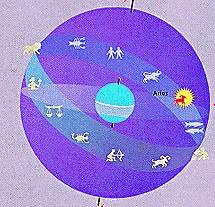
In the "geocentric" cosmology the sun was believed to move along this circle around the earth once a year. The other cosmic circle shown here, parallel to the earth's equator, is called the "celestial equator."
Because the ancients believed in the real existence of the great sphere of the stars, its various parts-- such as its axis and poles-- played a central role in the cosmology, religion, and theology of the time. In particular, one important attribute of the sphere of the stars was much better known in antiquity than it is today: namely, its equator, known as the "celestial equator." Just as the earth's equator is defined as a circle around the earth equidistant from the north and south poles, so the celestial equator was understood as a circle around the sphere of the stars equidistant from the sphere's poles. The circle of the celestial equator was seen as having a particularly special importance because of the two points where it crosses the circle of the zodiac: for these two points are the equinoxes, that is, the places where the sun, in its movement along the zodiac, appears to be on the first day of spring and the first day of autumn. Thus the celestial equator was responsible for defining the seasons, and hence had a very concrete significance in addition to its abstract astronomical meaning.
It is this phenomenon of the precession of the equinoxes that provides the key to unlocking the secret of the astronomical symbolism of the Mithraic tauroctony. For the constellations pictured in the standard tauroctony have one thing in common: namely, they all lay on the celestial equator as it was positioned during the epoch immediately preceding the Greco-Roman "Age of Aries." During that earlier age, which we may call the "Age of Taurus," lasting from around 4,000 to 2,000 B.C., the celestial equator passed through Taurus the Bull (the spring equinox of that epoch), Canis Minor the Dog, Hydra the Snake, Corvus the Raven, and Scorpio the Scorpion (the autumn equinox): that is, precisely the constellations represented in the Mithraic tauroctony.
 In
the diagram to the left notice that the celestial equator intersects the
zodiac in Aries. This was the situation during the "Age of Aries."
The sun is here pictured (in Aries) as it was located on the day of the
spring equinox in that age.
In
the diagram to the left notice that the celestial equator intersects the
zodiac in Aries. This was the situation during the "Age of Aries."
The sun is here pictured (in Aries) as it was located on the day of the
spring equinox in that age.
Here, to the right you can see how the cosmic axis has wobbled, so
that the celestial equator intersects the zodiac in Taurus-- the situation during the |"Age of Taurus." The sun
is here pictured (in Taurus) as it was located on the day of the spring
equinox in that age. In this "Age of
Taurus" the celestial equator passed through Taurus, Canis Minor,
Hydra, Corvus, and Scorpio: precisely the constellations pictured in the
Mithraic bull-slaying icon.
in Taurus-- the situation during the |"Age of Taurus." The sun
is here pictured (in Taurus) as it was located on the day of the spring
equinox in that age. In this "Age of
Taurus" the celestial equator passed through Taurus, Canis Minor,
Hydra, Corvus, and Scorpio: precisely the constellations pictured in the
Mithraic bull-slaying icon.
In fact, we may even go one step further. For during the Age of Taurus, when the equinoxes were in Taurus and Scorpio, the two solstices-- which are also shifted by the precession-- were in Leo the Lion and Aquarius the Waterbearer (In the above diagram of the "Age of Taurus," Leo and Aquarius are the northernmost and southernmost constellations of the zodiacal circle respectively-- these were the positions of the summer and winter solstices in that age). It is thus of great interest to note that in certain regions of the Roman empire a pair of symbols was sometimes added to the tauroctony: namely, a lion and a cup. These symbols must represent the constellations Leo and Aquarius, the locations of the solstices during the Age of Taurus. Thus all of the figures found in the tauroctony represent constellations that had a special position in the sky during the Age of Taurus.
The Mithraic tauroctony, then, was apparently designed as a symbolic representation of the astronomical situation that obtained during the Age of Taurus.
Answer for yourself: But what religious significance could this have had, so that the tauroctony could have come to form the central icon of a powerful cult?
The answer to this question lies in the fact that the phenomenon of the precession of the equinoxes was unknown throughout most of antiquity: it was discovered for the first time around 128 B.C. by the great Greek astronomer Hipparchus. Today we know that the precession is caused by a wobble in the earth's rotation on its axis. However, for Hipparchus-- because he held to the ancient geocentric cosmology in which the earth was believed to be immovable-- what we today know to be a movement of the earth could only be understood as a movement of the entire cosmic sphere. In other words, Hipparchus's discovery amounted to the discovery that the entire universe was moving in a way that no one had ever been aware of before! But this is not quite true because my research into Egyptian religion has proved beyond a shadow of any doubt that the Hyskos Pharoah Kings, who are, by many, linked to the Patriarchs of the Old Testament, were well aware of this "precession of the equinoxes" and this was the prime reason for the existence of the two divisions of Egypt which were based more on religious differences (Taurus versus changing to Aries/Lamb). It can be shown, and is being show by archeology as well as Egyptologists today that the movement toward monotheism within Egypt by Moses and other Pharaohs is connected to the realization by them that the One God is responsible for not only the creation of the cosmos but the changing and moving of it as well. What is important for us to note is that BOTH Egypt and Asia Minor noticed the same things in the heavens; that Taurus was being replaced by Aires and this alteration of "Taurus" centered worship in Egypt was not easy to change. Thus the Exodus to separate from and purify a religions which saw that God was doing a new thing in the heavens. Good books like A. Osman's Out Of Egypt and Ralph Ellis' Jesus The Last Of The Pharoah's will show you in detail the real story behind our Old Testaments and how this secret knowledge is the background for many Old Testament events of which we read not fully understanding the dynamics behind what motivated them. Be not mistaken...once you read this then the implications the the religion presented in the New Testament is nothing less than a continuation of astro-worship.
At the time Hipparchus made his discovery, Mediterranean intellectual and religious life was pervaded by astrological beliefs. It was widely believed that the stars and planets were living gods, and that their movements controlled all aspects of human existence. In addition, at this time most people believed in what scholars call "astral immortality;" that is, the idea that after death the human soul ascends up through the heavenly spheres to an afterlife in the pure and eternal world of the stars. In time, the celestial ascent of the soul came to be seen as a difficult voyage, requiring secret passwords to be recited at each level of the journey. In such circumstances, Hipparchus's discovery would have had profound religious implications. A new force had been detected capable of shifting the cosmic sphere: was it not likely that this new force was a sign of the activity of a new god, a god so powerful that he was capable of moving the entire universe?
Hipparchus's discovery of the precession made it clear that before the Greco-Roman period, in which the spring equinox was in the constellation of Aries the Ram, the spring equinox had last been in Taurus the Bull. Thus, an obvious symbol for the phenomenon of the precession would have been the death of a bull, symbolizing the end of the "Age of Taurus" brought about by the precession. And if the precession was believed to be caused by a new god, then that god would naturally become the agent of the death of the bull: hence, the "bull-slayer."
This, is the origin and nature of Mithras the cosmic bull-slayer. His killing of the bull symbolizes his supreme power: namely, the power to move the entire universe, which he had demonstrated by shifting the cosmic sphere in such a way that the spring equinox had moved out of Taurus the Bull.
Given the pervasive influence in the Greco-Roman period of astrology and "astral immortality," a god possessing such a literally world-shaking power would clearly have been eminently worthy of worship: since he had control over the cosmos, he would automatically have power over the astrological forces determining life on earth, and would also possess the ability to guarantee the soul a safe journey through the celestial spheres after death.
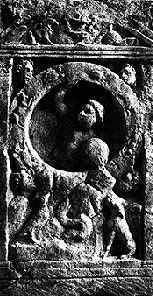 That
Mithras was believed to possess precisely such a cosmic power is in fact
proven by a number of Mithraic artworks depicting Mithras in various ways
as having control over the universe. For example, one scene shows a
youthful Mithras holding the cosmic sphere in
one hand while with his other hand he rotates the circle of the zodiac.
That
Mithras was believed to possess precisely such a cosmic power is in fact
proven by a number of Mithraic artworks depicting Mithras in various ways
as having control over the universe. For example, one scene shows a
youthful Mithras holding the cosmic sphere in
one hand while with his other hand he rotates the circle of the zodiac.
Above we "hinted" as what we will now discuss in detail.
As a result, the celestial equator was often described in ancient
popular literature about the stars. Plato, for example, in his dialogue
Timaeus said that when the Creator of the universe first formed
the cosmos, He shaped its substance in the form of the
letter X (a cross),
representing the intersection of the two celestial circles of the
zodiac and the celestial equator. This cross-shaped symbol was often
depicted in ancient art to indicate the cosmic sphere. In
 fact,
one of the most famous examples of this motif is a Mithraic stone carving
showing the so-called "lion-headed god," whose image is often
found in Mithraic temples, standing on
a globe that is marked with the cross
representing the two circles of the zodiac and the celestial equator and
their intersection forming a "cross." Notice
if you will this "Lion-headed god standing on globe with crossed
circles."
fact,
one of the most famous examples of this motif is a Mithraic stone carving
showing the so-called "lion-headed god," whose image is often
found in Mithraic temples, standing on
a globe that is marked with the cross
representing the two circles of the zodiac and the celestial equator and
their intersection forming a "cross." Notice
if you will this "Lion-headed god standing on globe with crossed
circles."
The celestial equator and the ecliptic intersect at two points, [forming a cross], and these two crosses or points are the equinoxes: the places where the sun, in its movement through the zodiac as seen from the earth, and is understood as the first days of spring and autumn. But understand this was understood to happen not on earth; the sun was submitted to these "crosses" in the heavens. The sun was crucified in the heavens. The ancients understood that the seasons were changed and determined by the travel of the sun; either above or below the equator. When the sun, which was though to be dead in winter with the longer days of darkness, rose above the equator, then the sun was subjected to this "cross" in its movement above the celestial equator in its elliptical orbit; the sun was though to be subjected to this "cross" or "crucified" and after 3 days, when the sun remained at the lowest point in the horizon and thought to be dead, it miraculously began it upward trajectory and with it the promise of spring and new life was on its way. The ancients understood this as the "sun being crucified on the cross."
But it does not stop here.
As stated above Mithra was connected with the killing of winter, Taurus the bull. The rite of initiation into Mithraic cults involved the slaying of a bull over a naked body of the candidate in such a way that the blood of the bull poured over him. He was "washed in the blood of the bull." The baptism by the blood of a bull (taurobolium, for the rich) or the blood of a ram (criobolium, for the poor) was a means of attaining a second birth. The pits around Mithraic altars suggest that the worshippers were bathed ritually in hot blood. If no bull was available, other animals were used. If a lamb was used they were "washed in the blood of the lamb." In the course of this gruesome ceremony the initiate was to drink some of the blood, thereby gaining the courage and strength of the bull or whatever animal that was sacrificed. They believed in the eating of this representative of the God they obtained the very attributes of the God. This was followed by a Eucharistic meal of the bull or animal's flesh.
The divine meal is more frequently portrayed than any other scene except the bull slaying. Besides bull meat, other animals were used, or bread and fish were used as substitutes for meat, and wine for blood. This was their Eucharist! They believed that by eating the bull's flesh and drinking its blood they would be "born again" just as life itself had once been created from the bull's blood. It was believed that the partaking of the Eucharistic sacrament ensured Eternal Life, the immediate passing after death, to the bosom of Mithra, there to tarry in bliss until the judgment.
Mithras was born of the Sun God and a virgin mother, called "the Mother of God, on December 25th. Mithras was considered the savior of mankind, and stories abound of his healing the sick, raising the dead, and performing miracles. He was seen by his devotees as the "mediator between Heaven and earth and was associated with a "holy trinity." He remained celibate until the ripe old age of 64. The name "Mithras" comes from the Persian word for "contract;" being known as "the keeper of the covenant."
Here in the end we may sense a profound kinship between Mithraism and Christianity.
For early Christianity also contained at its core an ideology of cosmic transcendence. Nowhere is this better expressed than in the opening of the earliest gospel, Mark. There, at the beginning of the foundation story of Christianity, we find Jesus, at the moment of his baptism, having a vision of "the heavens torn open." Just as Mithras is revealed as a being from beyond the universe capable of altering the cosmic spheres, so here we find Jesus linked with a rupture of the heavens, an opening into the numerous realms beyond the furthest cosmic boundaries. Perhaps, then, the figures of Jesus and Mithras are to some extent both manifestations of a single deep longing in the human spirit for a sense of contact with the ultimate mystery.
As the final pagan religion of the Roman Empire, Mithraism paved a smooth path for Christianity by transferring the better elements of paganism to this new religion (Cumont, The Oriental Religions in Roman Paganism).
The absurdity with which Christianity enveloped Roman paganism was characterized by the early Church writer Tertullian (160-220 A.D.), who noticed that the pagan religion utilized baptism as well as bread and wine consecrated by priest. Tertullian wrote that Mithraism was inspired by the devil, who wished to mock the Christian sacraments in order to lead faithful Christians to hell.
Mithraism was similar to Christianity in:
These similarities make conversion of its followers to Christian doctrine very easy!
Traces of paganism still present in Christianity prove that Christians did borrow from paganism, and we know from the statements of the Church Fathers that they saw many of the same concepts in Christianity as in the pagan religions which already existed when Christianity was invented.
The doctrines of Christianity are an outgrowth from the older faiths, in many ways similar, religions, with similar doctrines and principles. Only priests and preachers who love their salary more than the cause of truth, historically a very large class, or who are deplorable ignorant of history, have the effrontery to continue the pretense that Christianity was uniquely revealed. But truth has a way of emerging in spite of efforts to evade, ignore, or invalidate it.
You will have to decide who is mocking whom?